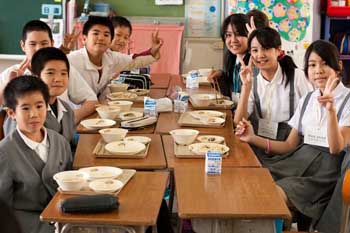|
Cartoons of
Dan McConnell
featuring
Tiny the Worm
Cartoons of
David Logan
The People's Comic
Cartoons of
John Jonik
Inking Truth to Power
|
Support the WA Free Press. Community journalism needs your readership and support. Please subscribe and/or donate.
posted July 24, 2009

Lunchbreak at Kadena Elementary. Students serve the teachers and themselves, eat fresh food, then clean up as well.
photo by the author
What Japanese Schools are Doing Right
By Bill Costello
In March, I had the opportunity to visit a Japanese school. Kadena Elementary School is located on Okinawa Island in the town of Kadena, and is not to be confused with the school of the same name operated by the US Department of Defense Dependents Schools (DoDDS).
The purpose of my visit was to research successful aspects of the Japanese school system that could be used to improve the American school system. As an educational researcher, I believe that cultures should borrow the best practices from each other.
During my visit to Kadena Elementary, I observed several practices that worked well and could be adopted by American schools.
First, Kadena Elementary has a social curriculum in addition to an academic curriculum. For example, the students clean the school every day by themselves; there is no janitor. They sign up for chores on the blackboard. The Japanese custom of removing street shoes at the front door of the school and replacing them with shoes that are only worn indoors makes cleaning somewhat easier.
Also, the students serve the school lunch to the teachers and themselves; there are no cafeteria workers. After lunch, the students clean up after themselves.
The social curriculum helps students develop autonomy, responsibility, and a strong work ethic. It’s an idea that could work well in American schools.
The second practice I observed that worked well is that the students eat a healthy diet. There are no soda vending machines at Kadena Elementary. The school lunch is planned by a dietician and prepared at a central location in the school’s district. It is then delivered daily to every elementary school, middle school, and high school in the district. Japanese schools do not have cafeterias. Students eat lunch in the classroom with their homeroom teacher.
The school lunch I ate at Kadena Elementary consisted of rice, soup, broiled fish, and milk. By comparison, the American school lunch typically consists of processed foods that are higher in fat and sugar.
Third, the students stay active at Kadena Elementary. They have recess every day and participate in a rigorous physical exercise program. In contrast, American schools are cutting back or completely eliminating recess and physical education.
Besides recess and physical education, the students also stay active in the classroom. I observed classrooms wherein students were not just passively sitting still listening to the teacher; they stood up and moved around while learning. They played educational games and learned by seeing, hearing, and doing.
Studies show that proper nutrition and increased physical activity lead to higher academic achievement. American schools can improve student learning by serving a healthier school lunch and giving students more opportunities to stay active during the school day.
Japan has outperformed the US in math and science on several international assessments of educational achievement. For example, the average math achievement score for 15-year-old Japanese students was 523 on the most recent Program for International Student Assessment (PISA). American students only scored 474.
In science, Japanese students outperformed American students 531 to 489.
The Japanese school
system is teaching math and science to students more effectively than
the American school system, and it still has enough resources left over
to implement a social curriculum, offer healthy food, and allow students
to stay physically active during the school day. These are all great
practices that American schools should consider borrowing.
Bill Costello, training director of Making Minds Matter, teaches parents and teachers the best strategies for educating boys. He can be reached at www.makingmindsmatter.com or trainer@makingmindsmatter.com.


